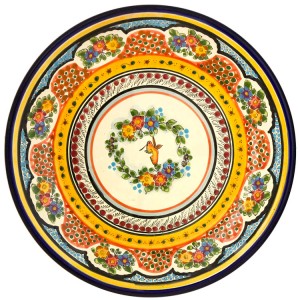Th e period between 1650 and 1750 was known as the Golden Age of Talavera. Puebla became the most important earthenware center of New Spain. Pieces were shipped all over the territory, and were sent to Guatemala, Cuba, Santo Domingo, Venezuela and Colombia. During this time, the preferred use of blue on Talavera pottery was reinforced by the influence of China’s Ming dynasty through imported Chinese ceramics that came to Mexico via the Manila galleons. Italian influences in the 18th century introduced the use of other colors.
e period between 1650 and 1750 was known as the Golden Age of Talavera. Puebla became the most important earthenware center of New Spain. Pieces were shipped all over the territory, and were sent to Guatemala, Cuba, Santo Domingo, Venezuela and Colombia. During this time, the preferred use of blue on Talavera pottery was reinforced by the influence of China’s Ming dynasty through imported Chinese ceramics that came to Mexico via the Manila galleons. Italian influences in the 18th century introduced the use of other colors.
During the Mexican War of Independence, the potters’ guild and the ordinances of the 17th century were abolished. This allowed anyone to make the ceramic in any way, leading to a decline in quality. The war disrupted trade among the Spanish colonies and cheaper English porcelain was being imported. The Talavera market crashed. Out of the forty-six workshops that were producing in the 18th century, only seven remained after the war.
In 1897, a Catalan by the name of Enrique Luis Ventosa arrived to Puebla. Ventosa was fascinated by the history of the craft which was unique from other art forms in Mexico. He studied the original processes and combined it with his knowledge of contemporary, Spanish work. He published articles and poems about the tradition and worked to decorate ceramic pieces. In 1922, he befriended Ysauro Uriarte Martinez, a young potter, who had inherited his grandfather’s workshop. The two men collaborated to create new decorative designs, adding pre-Columbian and Art nouveau influences to the Islamic, Chinese, Spanish and Italian influences that were already present. They also worked to restore the former levels of quality. Their timing was good as the Mexican Revolution had ended and the country was in a period of reconstruction.
